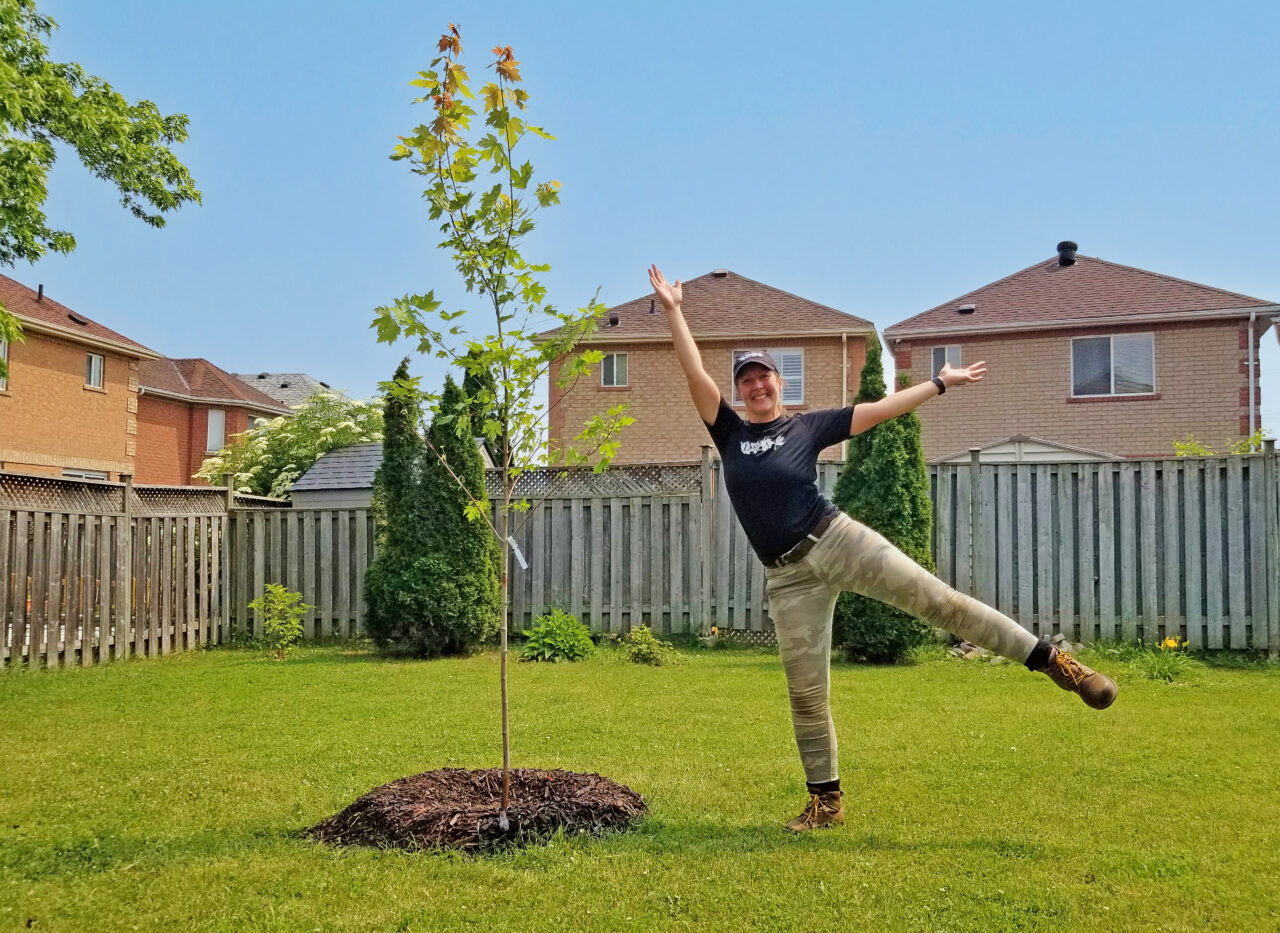Tree Equity Score Analyzer (TESA) Toronto is the first urban forestry tool of its kind launched for a city outside the United States. Brought about through a partnership between the City of Toronto, LEAF (Local Enhancement and Appreciation of Forests), and American Forests, TESA Toronto provides transformative, high-resolution data to guide equity-focused urban forestry planning and practices in the city.
Join us as we explore how American Forests’ innovative tool is changing the game for Toronto’s urban foresters. Read highlights from our conversation with key partners who made TESA Toronto a reality.

Kim Statham
Director, Urban Forestry
Parks, Forestry and Recreation | City of Toronto

Janet McKay
Executive Director
LEAF (Local Enhancement and Appreciation of Forests)


Senior Manager, Geospatial Development and Analysis
GIS & Data Science Team | American Forests
American Forests developed the Tree Equity Score Analyzer for cities and states ready to bring Tree Equity to fruition. Tree Equity Score establishes an equity-first standard to guide investment in urban trees—crucial elements of urban infrastructure. Tree Equity Score is a single measure from 0 to 100 that combines measures of tree cover with indicators of social, health and climate priority. A score of 100 means that a neighborhood has adequate tree cover. Any score below 100 has a tree canopy need. The lower the score, the greater the need for investment.
American Forests worked closely with partners City of Toronto and LEAF, as well as an extended local stakeholder group, to adapt the Tree Equity Score methodology to Canada.

TESA Toronto provides deep-dive decision support to help plan targeted plantings, conservation efforts and engagement on public and private property. The application can be used to plan and prioritize site-level projects that move the needle on neighborhood Tree Equity Scores. Neighborhood and site-level information can also support door-to-door engagement, scenario planning, writing compelling grant proposals, budgeting and strategic planning.
“The Toronto TESA provides data to everyone. This means that folks who did not previously have easy access to this information may now be able to take part in the conversation.” –Janet McKay, LEAF
We spoke with partners about how and why TESA Toronto was developed, and how the tool is changing the conversation locally. Interviews have been edited and condensed.
The real-life impact of tree inequity on Toronto’s neighborhoods and what it means for residents:
Kim: Trees are one of the most visible ways to distinguish between neighbourhoods that are doing well and those that aren’t. Areas with low Tree Equity Scores align most closely to areas with a higher health burden and high heat disparity. The TESA mapping tool helps to visualize how trees are correlated with healthier neighbourhoods and how to create a plan to set and reach tree planting targets in any neighbourhood.
Janet: People who live in neighbourhoods that lack trees do not have access to immediate benefits like shade and cooling, noise buffering, and the connection to nature that comes from the diversity of insects, birds and other wildlife that trees support. They also do not share equally the health benefits that are provided by trees in an urban setting.

Photo Credit: City of Toronto

“The TESA mapping tool helps to visualize how trees are correlated with healthier neighbourhoods and how to create a plan for specific neighbourhoods to set and reach their target.” – Kim Statham, City of Toronto
How Tree Equity Score is increasing access to data and information:
Janet: The Toronto TESA provides data to everyone. This means that folks who did not previously have easy access to this information may now be able to take part in the conversation. [It’s a] powerful tool in the path toward establishing more equitable programs and practices.
Kim: Tree Equity is a strategic approach to expanding [Toronto’s] urban forest canopy by focusing on delivering measurable benefits, one neighbourhood at a time. The value of the Tree Equity Score Analyzer tool is that any resident or community group can access high quality data to inform tree planting plans for their neighbourhood. We are promoting the tool to start that conversation with community members about where they should be prioritizing tree planting to get the biggest impact for their efforts.
“Finding solutions here will require deep community engagement—listening to residents and working together to address the barriers and challenges.” –Janet McKay, LEAF
Taking a long-game Tree Equity approach:
Janet: Knowing what inequities exist in our canopy is important. But it’s just the first step. Knowing WHY those inequities exist and then learning HOW to correct them is the hard work ahead. Finding solutions here will require deep community engagement—listening to residents and working together to address the barriers and challenges. Only when we listen carefully and come up with action plans together with the residents of a community, will we have success.
Kim: Toronto City Council has adopted a tree canopy cover target of 40 percent by 2050. Planting trees in neighbourhoods that need it most is one strategy towards expanding the tree canopy. While the City of Toronto has an estimated 31 percent canopy cover, [the City’s 2018 Tree Canopy Study] highlighted the unequal distribution of this canopy cover, noting that not all communities were enjoying all the benefits of the urban forest. In response to this finding, the City partnered with American Forests to develop a Tree Equity Score Analyzer for Toronto, the first city outside of the US to have the tool.
Alexis: Groups in Toronto are incredibly dedicated to the advancement of Tree Equity. The stakeholder group critically considered the practical challenges of putting [TESA] into action. There is a great deal of excitement for the tool, and with it the understanding that it’s one piece of a larger puzzle to achieve Tree Equity.

Photo Credit: LEAF
How TESA Toronto was created and the collaborative efforts that made it possible:
Geri: Several adaptations were required to build Tree Equity Score based on data available in Canada. Canada does not use block groups, which are used in the US Census and are the unit for calculating US Tree Equity Scores. Instead, we used Census tracts, and made it possible to subset data by ward and Toronto’s designation of 158 neighborhoods. Canadian Census categories differ some from the U.S. Census. For example, the “People of Color” indicator was combined from two Canadian Census variables, “Visible Minority” with “Indigenous Identity,” to ensure all First Nations peoples were counted. Health data was sourced from an Ontario-based organization, Ontario Community Health Profiles Partnership.
Kim: Our stakeholder group included staff from a number of City divisions, academia and a local not-for-profit organization, Local Enhancement and Appreciation of Forests (LEAF). Areas with low Tree Equity Scores follow a similar pattern to Toronto’s Neighbourhood Improvement Areas and Emerging Neighbourhoods. These were identified by the City of Toronto as areas that are a priority for City investments to improve social, health and economic outcomes.
Alexis: The stakeholder group was very important for identifying local data and to help define opportunities for the use of the tool in the long-term. The process illuminated how the score can help identify areas of the city with highest need and inform tailored outreach strategies based on the social and demographic profiles of those neighborhoods. This can lead to greater accessibility to the Tree Equity and climate resilience work happening in Toronto and its benefits.

Photo Credit: City of Toronto
On plans for using TESA Toronto to create greener, healthier, and more equitable urban spaces.
Kim: The City’s Urban Forestry branch is already using the data from the Tree Equity Score Analyzer tool to inform a number of tree planting programs such as the residential street tree program. We are doing targeted outreach and engagement such as community tree planting events and tree tours in low Tree Equity neighbourhoods so people can learn more about the benefits of trees and how the City supports tree planting in their community. The City of Toronto is also providing grants and incentives for private tree planting, such as free giveaways of native trees and shrubs, that support individual and community tree planting on private land. While it’s not a requirement we are encouraging applicants to explore the TESA tool to help them prioritize and plan their project.
Janet: LEAF hopes to use TESA Toronto at a city-wide level to understand better what areas should be prioritized in our planting and education/engagement programs. Then, at a neighbourhood level, having the data in hand will allow us to better advocate for funding and other supports that communities identify as needed. I’m most excited about the fact that this one tool offers a very high-level, bird’s-eye view of the tree canopy, as well as very detailed information on a lot-by-lot basis. The combination of these two perspectives will be valuable.
Alexis: Tree Equity Score Analyzers are having a significant impact in communities across the United States where TESA is being used. For example, In Maricopa County, Arizona, TESA is being used by municipalities, utilities, nonprofit organizations, and community advocates across the valley to support prioritization and impact reporting. Tree Equity Score has been incorporated into the Shade Phoenix Plan and public health officials are using it to study the cross section of Tree Equity and heat disparity. Toronto might see a similar application for a diverse set of users and to address several dimensions of climate resilience.

City of Toronto is home to more than three million people whose diversity and experiences make this great city Canada’s leading economic engine and one of the world’s most diverse and livable cities. As the fourth largest city in North America, Toronto is a global leader in technology, finance, film, music, culture, innovation and climate action, and consistently places at the top of international rankings due to investments championed by its government, residents and businesses. For more information, visit www.toronto.ca or follow us on Instagram at www.instagram.com/cityofto or on Facebook at www.facebook.com/cityofto.

LEAF (Local Enhancement and Appreciation of Forests) is a not-for-profit organization dedicated to the protection and improvement of urban forests. For over 25 years, LEAF has been engaging residents through planting and stewardship programs. We seek to support vibrant communities where everyone benefits from a healthy urban forest. For more information, visit https://www.yourleaf.org/

American Forests’ Tree Equity Field Delivery Team supports use of Tree Equity Score Analyzers including facilitating training opportunities, supporting local organizations to incorporate Tree Equity Score tools into their everyday work, and drawing connections between Tree Equity Score and other work at the organization, such as tree planting and community engagement efforts. Our GIS & Data Science Team is a small, multi-disciplinary team of developers, data analysts and designers that bridges computer science, data analysis, data representation, visual design and interaction to build user-driven, mission-driven data applications like Tree Equity Score.